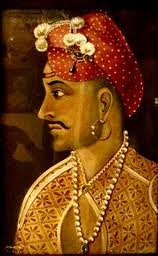Capture of Delhi (1760)
| Siege of Delhi (1760) | |||||||||
|---|---|---|---|---|---|---|---|---|---|
| Part of Afghan-Maratha War | |||||||||
 | |||||||||
| |||||||||
| Belligerents | |||||||||
|
| Durrani Empire | ||||||||
| Commanders and leaders | |||||||||
|
|
Yakub Ali Khan | ||||||||
| Strength | |||||||||
| Unknown | Unknown | ||||||||
The Capture of Delhi, fought in 1760, pitted the forces of the Maratha Confederacy against those of the Durrani Empire led by Yakub Ali Khan. The Maratha army was commanded by Sadashiv Rao Bhau, a prominent military leader and the brother-in-law of the Maratha Peshwa Balaji Baji Rao. The Durrani army, on the other hand, was led by Yakub Ali Khan, a trusted general of Ahmad Shah Durrani, the founder of the Durrani Empire.[3]
Siege
[edit]Bhau, accompanied by his allies, arrived in Agra on July 14 but was forced to abandon his plan of negotiating with Govind Ballal due to the high floods of the Jamuna river. Instead, he decided to move northward and avoid waiting for three months until the water receded. Bhau's advance guard, led by Malharrao, Jankoji, and Balwantrao Mehendele, attacked Delhi on July 22. The city fell, but the fort remained under Afghan control.[4] One hundred Maratha soldiers entered the fort undetected and began plundering the royal apartments. However, some were killed by Afghan guards, and others jumped down from the walls and broke their limbs. The fort was besieged and bombarded, and on July 27, Bhau arrived in Delhi on July 29[5] and negotiated peace terms with Yaqub Ali Khan, allowing him to depart safely with his family, property, and troops. Naro Shankar was appointed as the new subahdar of Delhi, and Baloji Palande was put in charge of the fort under Naro Shankar's authority.[6][7]
References
[edit]- ^ Mehta, B. L. Grover & Alka. A New Look at Modern Indian History : From 1707 to The Modern Times. S. Chand Publishing. ISBN 978-93-5501-683-6.
- ^ Kalikaranjan, Qanungo (1925). History Of Jats. p. 129.
- ^ Gupta, Hari Ram (2021-06-13). Marathas And Panipat. Panjab University, 1961. p. 153.
- ^ Gupta, Hari Ram (2021-06-13). Marathas And Panipat. Panjab University, 1961.
- ^ Grover, B. L.; Sethi, R. R. (1970). A New Look on Modern Indian History: From 1707 to the Present Day. S. Chand.
- ^ Sen, S. N. (2006). History Modern India. New Age International. ISBN 978-81-224-1774-6.
- ^ Roy, Kaushik (2011-03-30). War, Culture and Society in Early Modern South Asia, 1740-1849. Routledge. ISBN 978-1-136-79086-7.
